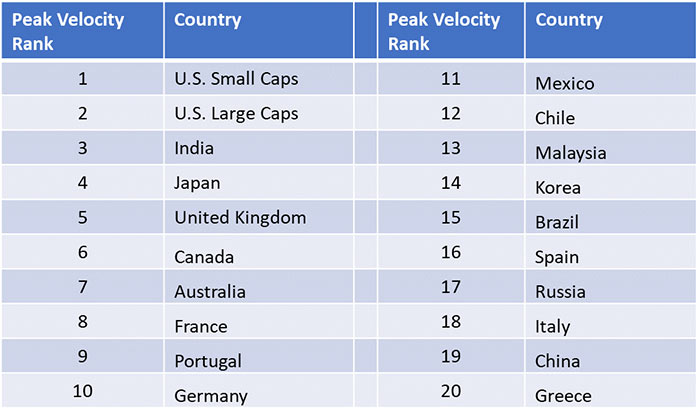Markets often follow a predictable pattern. In bull markets, times when prices generally go up, more aggressive positions gain more than conservative stocks.
Aggressive positions include stocks of small companies and speculative technology companies.
There’s a logical reason for that pattern. How investors feel, or investor sentiment, drives market action. Optimistic investors push prices up. Pessimistic investors push prices down.
This behavior tells us what to expect as prices rise. Optimists tend to invest more aggressively than pessimists. That means we see speculative positions like small-cap stocks perform better than large caps in bull markets.
This same idea applies around the world. Speculative positions like emerging market stocks perform the best in global bull markets.
But that’s not happening right now.
Peak Velocity
The table below shows the Peak Velocity ranks of countries around the world. U.S. stocks are the best performers.

Peak Velocity measures momentum. This indicator tells us how fast prices are rising or falling.
Academic research since the 1960s shows that momentum explains statistically why many stocks go up. There are, of course, stories behind the gains. But once a story takes hold, the price tend to move farther than the story justifies.
Momentum explains why stock prices go up too much in bubbles. It also explains why prices fall so far when the economy contracts.
I created Peak Velocity to compare the momentum of different stocks or markets. The table above sorts Peak Velocity from highest to lowest, with U.S. small-cap stocks at the top and Greek stocks at the bottom.
In the simplest terms, this table shows which markets to buy. Those are the highest-ranked markets. Investors should avoid the lowest-ranked markets.
Market Anomalies
The table also highlights unusual market behavior.
One anomaly is the fact that the U.S. is the best-performing market in the world right now. Usually, a smaller market with a faster-growing economy tops the list.
Another anomaly is the almost random nature of the list.
Often, we see regional markets move together. In other words, when one market in Europe is doing well, all European stock markets should do well. That’s not the case right now.
In technical terms, global markets show a wide dispersion of returns. Investors call this type of market “a market of stocks rather than a stock market.”
This is a time when investors should be selective.
Benefit From Bear and Bull Markets
Some countries are in bear markets right now. This includes Russia, Italy, China and Greece. There’s no clear link between these markets.
To benefit from bear markets, investors can buy put options on exchange-traded funds (ETFs) that track stocks in these countries. Options carry low risks and are an ideal tool for speculators.
Right now, put options on the Global X MSCI Greece ETF (NYSE: GREK) are the best trade.
Call options on ETFs tracking stocks in bull markets are also good trades right now. Calls allow investors to benefit from price gains.
Calls on the iShares Russell 2000 ETF (NYSE: IWM) are attractive.
Owning both puts and calls allow investors to benefit no matter which way markets move. That could be the ideal strategy for investors worried about the state of the world.
Regards,

Michael Carr, CMT
Editor, Peak Velocity Trader




